Sleuthing the Mundane and the Catastrophic
Water woes
More mundane than falling facades, but still vexing to building owners and occupants, is the common problem of water infiltration. The owner of an early-20th-century warehouse discovered that his heavy-timber and masonry-bearing-wall structure had this problem in the summer of 2001, just a year after its gut renovation and conversion to a corporate headquarters was completed, according to Dean Vlahos, AIA, a principal and head of forensics practice at Santa Monica, California−based WWCOT.
The owner, who asked that neither he nor the location of his building be identified, called in Vlahos after signs of water infiltration were found in a mechanical space located on the roof of the original five-story structure and below a new penthouse. During a routine inspection of the area, a member of the building's maintenance staff had noticed that the sheet metal covering the floor was buckling. Pulling back the metal revealed mold growth and deterioration in the floor assembly below. Although it was clear that water was the culprit, the source was far from immediately apparent. It took WWCOT a month and "a lot of head scratching" to determine the cause, says Vlahos.
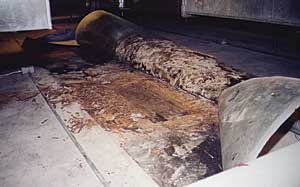 |
The owner of a former warehouse found evidence of water penetration in the building's mechanical space (left middle and bottom). |
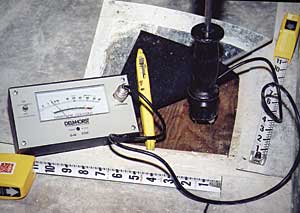 Images: Courtesy Wwcot |
WWCOT's investigation at first focused on the most likely suspects-the mechanical space's metal panel enclosure and the adjacent roof, where some evidence of moisture penetration had also been found. The firm water-tested these areas by saturating the surfaces and then applying food coloring, using different hues for each location to track the water's path. WWCOT tested roof penetrations and the heads of doors, windows, and louvers-wherever deficient flashing might lead to leaks.
Vlahos and his team conducted the water test twice. They performed the test once with the HVAC systems on, and again with them shut down. He had noticed that during normal hours of operation, the mechanical space was highly pressurized. He theorized that if warm air seeping out of the ductwork was causing this pressurization, then the negative pressure created when the mechanical systems were turned off might be drawing water in through small gaps in the space's enclosure. But no sources of water infiltration were found. "We couldn't get the building to leak," he says.
The investigators next looked at condensation as a possible source. Fluctuations in temperature and humidity might cause moisture to condense on the surfaces within the mechanical space. But monitoring of both temperature and humidity for a week in early February showed that the space was roughly 80 degrees, with 42 percent humidity. The conditions did not vary with the exterior conditions and were relatively constant, whether the mechanical systems were in operation or shut down.
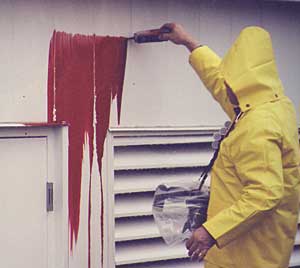 |
Water testing (left) ruled out leaks in the enclosure as the source. |
Although the temperature and humidity inside the mechanical space were constant, Vlahos thought that condensation might still be playing a role. At the prevailing environmental conditions, he calculated the surface temperatures of each of the components making up the floor assembly-sheet metal, building paper, plywood sheathing, and heavy timber tongue-and-groove planks. If the surface temperatures were below the dew point, condensation would form. Surface temperature is a function of each component's material properties, thickness, and thermal resistance, he explains. But this avenue of exploration also turned out to be a dead end. The analysis showed that the surface temperature of each of the layers of the floor assembly was above the dew point of 55 degrees.
The forensic team was stumped. "If the water is not from outside, and it's not from the inside, where was it coming from?" asks Vlahos.
Core samples of new wood used in the floor assembly had ruled out the possibility that these materials were already moldy or had too much moisture content when they arrived at the site. "We could see that the mold was not within the wood but was more topical," says Vlahos.
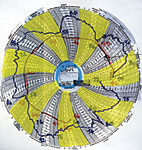 |
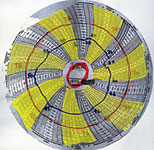 |
Monitoring of temperature and humidity inside the space (above right) showed that both were constant despite fluctuations in exterior conditions (above left). |
|
The clue that finally led to the source of water infiltration was vestiges of asphalt, found during destructive testing of the mechanical space floor and the adjacent roof. The asphalt, typically used to terminate completed areas of roof and prevent wind-driven rain from migrating underneath, was a sign of a wet construction season.
The asphalt, together with information from construction personnel interviews, refocused the investigation on the construction process itself. Intumescent paint, specified for the underside of the tongue-and-groove decking to increase the fire-resistant characteristics of the heavy timber structure, was extremely difficult to apply, according to the contractor. In order to make the paint adhere, the construction crew applied two, and in some areas three, coats of the paint, even though only one was required. This difficulty was an indication that the wood was already wet.
An overlay of the construction schedule and precipitation data for the 210-day period when contractors were roofing the structure and building the mechanical space's enclosure confirmed that 89 of those days were rainy. Through inspection of dated construction photos, Vlahos found that the decking and sheathing inside the mechanical space and on the roof were left largely unprotected and not given sufficient time to dry before encapsulation with other materials.
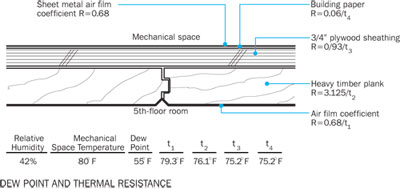 |
Calculation of the surface temperatures of each of the materials in the floor assembly showed that all were above the dew point. |
The layers of building paper and sheet metal on the mechanical- room floor, and insulation and built-up roofing on the exterior, trapped the water inside the organic materials, creating perfect conditions for mold growth and deterioration. The intumescent paint used on the underside of the tongue-and-groove decking further aggravated these conditions, forming a "sandwich," says Vlahos.
Correcting the problem involved a phased, five-month reconstruction of the damaged areas, performed while the building was occupied. Resolution did not require litigation-the contractor acknowledged not protecting the roof and mechanical space adequately during construction and assumed responsibility for the approximately $4 million repair. "The contractor stepped up to the plate," says Vlahos.









